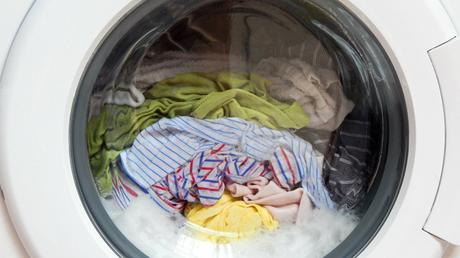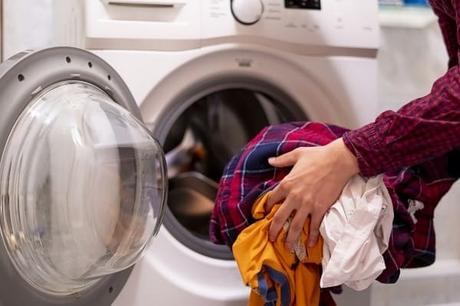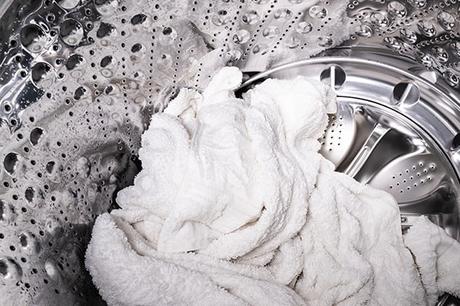Your clothes may be soaking wet after washing due to issues with the washing machine’s drainage system or an imbalance in the load. Excessive water not draining properly can result in clothes retaining more moisture than desired.
Common Causes Of Clothes Being Soaking Wet After Washing
Have you ever experienced the frustration of taking your clothes out of the washing machine, only to find them soaking wet? It’s not only annoying, but it can also be a real inconvenience, especially if you’re in a rush or have limited drying options. If you’re wondering why this happens, there are several common causes to consider.
Overloading The Washing Machine
One of the primary reasons your clothes may be soaking wet after washing is overloading the washing machine. When you overload the machine, there isn’t enough space for the water and detergent to effectively penetrate the fibers of your clothes. As a result, some garments may get trapped, hindering the spin cycle’s effectiveness and leaving your clothes heavier with absorbed water.
Issues With The Spin Cycle
The spin cycle is responsible for removing excess water from your clothes. However, if there are issues with the spin cycle, such as an imbalanced load, loose belts, or a malfunctioning motor, your clothes may not receive adequate spinning to remove the water effectively. As a result, you’ll find them dripping wet when you take them out.
Problems With The Drainage System
The drainage system of your washing machine plays a crucial role in removing water after the wash cycle. If there are problems with the drainage system, such as clogged pipes or a faulty pump, the water won’t properly drain, and your clothes will be left soaked. It’s essential to regularly check for any blockages or issues in the drainage system to prevent this from happening.
Now that you understand some of the common causes behind your clothes being soaking wet after washing, it’s crucial to address these issues to ensure proper laundering. By avoiding overloading the machine, maintaining the spin cycle, and checking the drainage system, you can enjoy thoroughly washed clothes that are ready for drying.

Credit: atoz1.com
How To Fix Clothes Being Soaking Wet After Washing
If you’re constantly facing the frustration of your clothes being soaking wet after they’ve gone through the washing cycle, don’t worry. There are several simple steps you can take to fix this issue and ensure your laundry comes out dry and ready to wear. In this section, we’ll outline some effective methods to troubleshoot and resolve the problem of wet clothes after washing.
Properly Load The Washing Machine
One of the most common reasons for clothes being excessively wet after washing is improper loading of the washing machine. To avoid this, follow these tips:
- Do not overload the machine: When the washing machine is overloaded, there isn’t enough space for the clothes to move and properly distribute the water during the wash cycle. This can result in poor rinsing and the clothes coming out wet.
- Distribute the load evenly: Make sure to distribute the clothes evenly around the drum. Uneven distribution can cause the machine to go off-balance, leading to inefficient spinning and wet clothes.
- Avoid large and heavy items: If you’re washing large or heavy items such as bedding or towels, try to wash them separately or with smaller lighter loads. Heavy items can absorb more water, making the spin cycle less effective.
Check The Spin Cycle Settings
The spin cycle is the crucial phase where excess water is removed from your clothes. If the spin cycle is not set correctly, it can leave your clothes sopping wet. Follow these steps to ensure the spin cycle settings are appropriate:
- Check the spin speed: Different washing machines offer varying spin speed options. Lower spin speeds are ideal for delicate or sensitive fabrics, while higher speeds are more effective at removing water from heavier items. Make sure you’ve selected the appropriate spin speed for your load.
- Double-check the spin duration: Some washing machines have customizable spin duration settings. Ensure that the spin cycle is not too short, as this may not give sufficient time for the water to be adequately drained.
Inspect And Clean The Drainage System
A clogged or faulty drainage system in your washing machine can cause water to accumulate during the washing cycle, resulting in wet clothes. Follow these steps to ensure the drainage system is properly inspected and cleaned:
- Clear the lint filter: Lint build-up in the filter can obstruct water flow during the drainage process. Locate the lint filter in your machine and remove any accumulated lint or debris. Regularly cleaning the lint filter improves drainage efficiency.
- Check the drain hose: Ensure the drain hose is not kinked or blocked. Straighten any bends or kinks in the hose and remove any obstructions that may be hindering water flow.
- Inspect the drainage pump: The drainage pump is responsible for expelling the water from the machine. Check for any signs of damage or blockages in the pump. If necessary, clean or replace the pump to optimize drainage performance.
By properly loading the washing machine, checking the spin cycle settings, and inspecting/cleaning the drainage system, you can effectively address the issue of clothes remaining soaking wet after washing. Following these simple steps will help ensure your laundry comes out dry, saving you both time and frustration.
Preventing Clothes From Becoming Soaking Wet After Washing
Are your clothes still soaking wet after washing? Discover effective methods to prevent this issue and keep your clothes dry and ready to wear.
It can be frustrating to pull your clothes out of the washing machine only to find them dripping wet. This not only adds extra time to your laundry routine but can also cause damage to your clothes and even lead to mildew growth. To avoid this issue, there are a few simple precautions you can take. Follow these tips to prevent your clothes from becoming soaking wet after washing.
Follow Manufacturer’s Guidelines
One of the simplest ways to prevent clothes from becoming soaking wet after washing is to follow the manufacturer’s guidelines. Each washing machine is different, and the settings and load capacity can vary. Pay attention to the recommended load capacity and avoid overstuffing the machine, as this can prevent proper water drainage and lead to excessively wet clothes. Additionally, follow the instructions for selecting the appropriate cycle for different types of fabrics to ensure the right amount of water is used.
Regularly Maintain The Washing Machine
A poorly maintained washing machine can contribute to clothes coming out soaking wet. Over time, debris, lint, and other residues can accumulate in the drain hose or the pump filter, causing water flow issues and inadequate draining. Regularly clean these components to ensure optimal performance and prevent clothes from retaining excess water. Refer to your washing machine’s manual to locate these parts and learn how to properly clean and maintain them.
Use The Appropriate Amount Of Detergent
The amount of detergent you use can also impact how wet your clothes become after washing. Using too much detergent can create excessive suds, making it difficult for the machine to rinse out all the soap effectively. This can lead to clothes that are not only wet but also feel sticky or slimy. Check the detergent packaging for recommended usage guidelines and measure the appropriate amount for each load. Avoid eyeballing or overpouring detergent to ensure thorough rinsing and minimize the chances of wet clothes.
By following these preventative measures, you can avoid the frustration of clothes coming out soaking wet after washing. By adhering to the manufacturer’s guidelines, maintaining your washing machine, and using the right amount of detergent, you can achieve properly cleaned and efficiently drained clothes every time. Implement these tips into your laundry routine for effective results.

Credit: www.solarappliance.net
Different Types Of Washing Machines
When it comes to doing laundry, we rely on our trusty washing machines to not only clean our clothes but also ensure they come out perfectly dry. However, if you’ve noticed that your clothes are coming out soaking wet after a wash cycle, it’s time to investigate the possible causes. One crucial factor to consider is the type of washing machine you have. Understanding the differences between top-load washing machines, front-load washing machines, and high-efficiency washing machines can help you identify the problem and find a suitable solution.
Top-load Washing Machines
Top-load washing machines are the classic choice for many households. They feature a vertical drum that is loaded from the top, hence the name. These washing machines are known for their simplicity and ease of use. However, they do tend to use more water compared to other types of machines, leading to heavier laundry loads.
If you find your clothes are soaking wet after washing in a top-load machine, several possible causes might be to blame. Firstly, overloading the machine can prevent adequate water drainage and hinder the spinning process. Secondly, if the machine’s spin cycle is not working correctly, it won’t effectively remove excess moisture from your clothes. Lastly, a malfunctioning drain pump or a clogged drain hose can cause water to accumulate in the drum, leaving your clothes wet after washing.
Front-load Washing Machines
Front-load washing machines have gained popularity in recent years due to their energy efficiency and gentle cleaning capabilities. With a horizontal drum that opens from the front, these machines use gravity to tumble and agitate the clothes, requiring less water and detergent in the process.
If you’re experiencing wet clothes after using a front-load washing machine, there are a few factors to check. Firstly, make sure you’re not overloading the drum, as this can prevent proper spinning and drainage. Additionally, check if the machine’s spin speed is set to an appropriate setting, as a low spin speed may not remove enough moisture. Lastly, examine the rubber door seal for any signs of damage or blockage, as this can affect the machine’s ability to drain properly.
High-efficiency Washing Machines
High-efficiency (HE) washing machines combine the energy efficiency of front-load machines with additional features to optimize water usage and cleaning performance. These machines are designed to use less water and energy, making them an environmentally friendly option.
If you’re facing the issue of wet clothes after using an HE machine, there are a few aspects to consider. Firstly, ensure you’re using the appropriate amount of high-efficiency detergent, as using regular detergent can create excessive suds and prevent proper rinsing. Secondly, check the machine’s settings to ensure the spin cycle is set at a suitable speed. Lastly, like with front-load machines, inspect the rubber door seal for any potential issues that may hinder efficient drainage.
The different types of washing machines can help pinpoint the reasons behind soaking wet clothes. Whether you own a top-load, front-load, or high-efficiency machine, familiarizing yourself with their specific characteristics and potential problems will enable you to troubleshoot and resolve the issue effectively. By ensuring proper loading, maintaining the machine, and addressing any mechanical or drainage problems, you can enjoy dry and clean clothes after every wash cycle.
Seeking Professional Help For Persistent Issues
If you find that your clothes are soaking wet after washing, despite using the appropriate settings, it may indicate a persistent issue. Seeking professional help can help diagnose and resolve the problem effectively.
If you find yourself constantly dealing with soaking wet clothes after every wash, it may be time to seek professional help. While some issues can be resolved with simple troubleshooting, persistent problems often require the expertise of a professional technician. In this section, we will explore the various options available to tackle this problem. Whether it’s consulting a professional technician, exploring warranty and insurance options, or considering replacement or upgrades, taking proactive steps will ensure that you can enjoy dry clothes after every wash.
Consulting A Professional Technician
Sometimes, the root cause of your soaking wet clothes may not be readily apparent. Consulting a professional technician can help you identify and address the underlying issues. Not only do they possess the necessary knowledge and experience, but they also have access to specialized tools and equipment. Professional technicians can assess your washing machine, diagnose the problem accurately, and provide you with targeted solutions. Whether it’s a faulty pump, clogged drainage system, or mechanical malfunction, their expertise can save you from the frustration of wet laundry.
Exploring Warranty And Insurance Options
If your washing machine is relatively new or still covered by a warranty or insurance plan, now is the time to make use of those benefits. Refer to the terms and conditions of your warranty or insurance policy to determine if the current issue falls under their coverage. Reach out to the manufacturer or your insurance provider to file a claim and schedule a repair. This way, you can get the necessary repairs done while minimizing out-of-pocket expenses. Don’t forget to gather all the required documentation and proof of purchase to streamline the process.
Considering Replacement Or Upgrades
In some cases, persistent issues with your washing machine may indicate that it’s time for a replacement or an upgrade. If your machine is quite old or has been showing signs of repeated malfunctions, it might be more cost-effective to invest in a new one. Upgrading to a newer model can provide you with more advanced features, better energy efficiency, and enhanced performance. Before making a decision, consider factors such as your budget, the lifespan of your current machine, and the potential savings in the long run. Research different brands and models to find the best fit for your needs.
Taking the initiative to seek professional help for persistent issues with wet clothes can help you resolve the problem effectively. Whether you consult a professional technician, explore warranty and insurance options, or consider a replacement or upgrade, the goal is to ensure that your laundry comes out dry and ready to wear. Don’t let wet clothes dampen your day any longer – take action and restore the convenience of a reliable washing machine.

Credit: codysappliancerepair.com
Frequently Asked Questions Of Why Are My Clothes Soaking Wet After Washing?
What Do You Do If Your Clothes Are Soaking Wet After Washing?
If your clothes are soaking wet after washing, adjust the settings for a higher spin speed, or select a longer spin cycle. Check for a clogged drain hose or filter, and ensure the machine is balanced. If the problem persists, contact a professional technician for assistance.
Is It Ok To Put Soaking Wet Clothes In The Dryer?
It is not recommended to put soaking wet clothes in the dryer. The excessive moisture can cause the dryer to work less efficiently and may lead to damage or shrinking of the clothing. It’s best to first wring out the clothes or use a spin cycle on your washing machine before drying them.
Why Is My Washing Machine Not Spinning Out All The Water?
Your washing machine may not be spinning out all the water due to a few possible reasons. It could be a problem with the motor, belt, or lid switch. Check these components and make sure they are functioning properly. If the issue persists, it may be best to contact a professional for further assistance.
Why Is There Water In My Washing Machine After Washing?
After washing, water may remain in the washing machine due to incomplete draining or a clogged drain pipe. This can be caused by blockages or malfunctions in the machine’s pump or drain filter. Cleaning or repairing these components should resolve the issue.
Why Are My Clothes Still Wet After Washing?
There are several reasons why your clothes may still be wet after washing, including overloading the machine, using the wrong wash cycle, or having a faulty washer.
Conclusion
To recap, excessive moisture in your clothes after washing can be caused by various factors. Improper balance of the washer load, overloading the machine, or a malfunctioning drainage system are some common culprits. By following proper laundry practices, such as sorting clothes, using the correct detergent, and addressing any potential issues with your washing machine, you can prevent your clothes from coming out soaking wet.
Keep these tips in mind to ensure your laundry routine results in dry and clean clothes every time.
